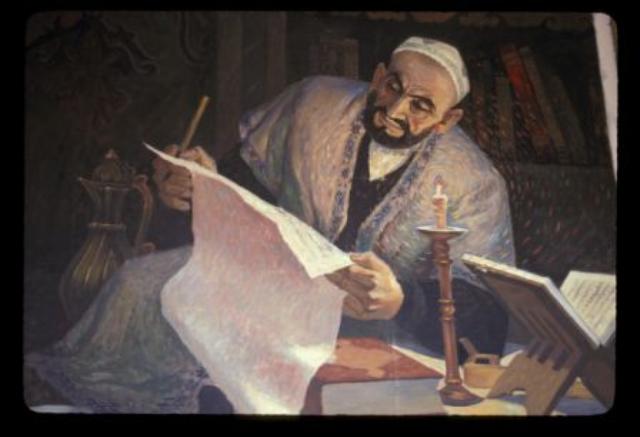

Annotated Turki Manuscripts Online (ATMO) · Uyghur Light Verbs
People presently involved in the project include:
(ATMO-1 and ATMO-2) Graduate Research Assistant (2015-2022), Chaghatay and economic anthropology specialist. KU Anthropology PhD candidate (co-chairs: Prof. Arienne M. Dwyer and Prof. David Smith).
Within the projects, he transcribes manuscripts, performs tandem proofreading, grammatical analysis, and annotation, and co-authors publications. Has written on the influence of Al-Farabi on current Uyghur thought and is drafting a dissertation on the commodification of Uyghur society.
(UyLVs, ATMO-1, ATMO-2) Principal investigator, Documentary Linguist, Language contact specialist.
For all three projects: Project director; grant author and recipient. Responsible for project conceptualization and analysis. Hired, trained, and evaluates student assistants. Directs project on a day-to-day basis. Primarily responsible for publications. Responsible for reporting to the Luce Foundation and the U.S. National Science Foundation.
She is the co-author of the textbook Greetings from the Teklimakan: A handbook of modern Uyghur.
(ATMO-2) Co-Investigator; Professor of Computational Linguistics, Department of Linguistics, Indiana University.
Prof. Kuebler was the impetus to test automated strategies for segmentation and part of speech annotation (done manually in UyLVs and ATMO-1). She and her assistant Kenneth Steimel developed and tested three different architectures for POS tagging, one based on a neural architecture, and two based on conditional random fields.
(ATMO-1, ATMO-2) Consultant; Director of Research at the Centre National de la Recherche Scientifique, Paris.
He is a historian of Islam in Central Asia from the 16th century to present. His main publications include: Soufisme et politique entre Chine, Tibet et Turkestan (2005), Mystiques et vagabonds en islam (2010), Central Asian Pilgrims (co-ed., 2011), L'Autorité religieuse et ses limites en terres d'islam (co-ed., 2013), Family Portraits with Saints (co-ed., 2013).
Within the project, he is responsible for much of the specialized information in the ATMO-1 project's handbook for work on Turki manuscripts, and on many aspects of the geneaological scroll in ATMO-2.
(ATMO-2) Co-investigator; Curators' Distinguished Professor, Department of English, University of Missouri-Kansas City. He is also the Director of UMKC's Classical and Ancient Studies Program, and is an affiliated faculty member in its Department of Computer Science.
Within the project, he has used network analysis to analyze the manuscripts in the collection, and helped with aspects of the project's XML.
The people listed here contributed to one or more of the projects in the past, but are not active in the current project's current work.
Founder and principal, Black Mesa Technologies, LLC.
(Uyghur Light Verbs, ATMO-1) Responsible for many aspects in both the Uyghur Light Verbs and ATMO-1 projects in making good use of XML and other information technologies. For example, the inspired displays of Prov. 351 are his design.
(ATMO-1) Associate professor of computational linguistics (Xinjiang University).
Evaluated morphological tagset and is assisting with legacy format conversion (2017-18).
(Uyghur Light Verbs, ATMO-1, ATMO-2) Graduate Research Assistant (2011-2017), KU Anthropology Ph.D., 2019 (advisor: Dr. Arienne M. Dwyer); now a Preceptor of Chaghatay and modern Uyghur at Harvard University).
After putting up patiently with extensive training in all three projects (in Chaghatay, in linguistic glossing, transcription, transliteration, and XML basics), Gülnar found her niche in interlinear glossing; she also served as a consultant for the modern Uyghur elicitations sponsored by UyLVs. In the ATMO project, she specialized primarily in manuscript transcription and tandem proofreading, together with morphological annotation.
(ATMO-1) Consultant on transcription and transliteration scheme, summer 2015.
PhD in Latin at Lund University, Sweden.
(ATMO-1) Transcribed and translated Swedish commentary in some manuscripts.
Professor at UMass-Amherst, typologist.
(Uyghur Light Verbs) We occasionally consulted Prof. Harris to review our test criteria and results.
Undergraduate research assistant, Linguistics/Anthropology/Arabic, 2011-2012
(Uyghur Light Verbs) Jamie assisted in structuring, tagging, and analyzing the corpus by doing data entry and metadata management. Initially Latin-script texts, she entered these (by keying or correcting OCRs of) non-digital Latin-script sources (Perso- Arabic-script) and created provenance metadata.
(Uyghur Light Verbs) Thanks are also due to Prof. Dr. Dafydd Gibbon (U Bielefeld emeritus) for valuable early discussions on computational lexicography, as well as many hours of transcoding experiments.
(UyLVs, 2011-2014) Graduate Research Assistant, then a KU Linguistics PhD student; now a UCLA PhD candidate.
(Uyghur Light Verbs) Travis primarily assisted in structuring, tagging, and syntacticallyl analyzing the modern Uyghur part of the corpus. After extensive training for more than two years, Travis did a first draft of corpus annotation. With co-GRA Gülnar Eziz, he tested and analyzed the corpus and devised elicitation strategies. This project-funded and project-mentored work directly supported Travis' MA thesis (on Uyghur islanding) and PHD research (on Uyghur complementizer clauses). See Günar and Travis' elicitation results in the sample texts.
Graduate Research Assistant, technical support (former KU Slavic linguistics PhD student), 2012.
(Uyghur Light Verbs) Within the project, he wrote software to automate orthographic conversions, and also assisted with Russian-language material.
(Uyghur Light Verbs) Volunteer Graduate Assistant while then working towards a Rice University Ph.C., discourse specialist, Summer 2011.
(UyLVs) Worked with Gülnar Eziz on the annotation of Uyghur discourse for the corpus in Summer 2011.
Credit: Painting of Mahmud al-Kashgari © 1981 by Ghazi Emet.